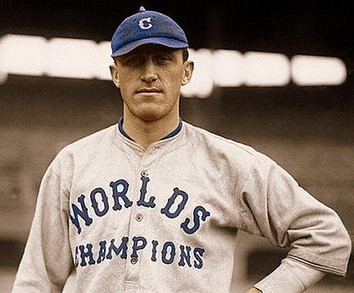1921 Indians: 94-60 record (.610); 95-59 pythag (.617)
On paper, this was the least competitive of the Cleveland pennant races, with them finishing 4.5 games back. However, that is very misleading. The Indians were tied for first with the Yankees with just six games left to play. Alas, the Indians lost five of those six to drop well behind the Yankees.
It’s a shame, because the Indians led for most of the season despite injuries to some key players. Veteran second baseman Bill Wambsganss missed almost all of the first two months with injuries. More importantly, two of their three big pitchers from the year before were no longer effective. Bagby had dead arm, and his ERA inflated to 4.70. He never would be the same after his big 1920. Caldwell was even worse, winning just six games and spending most of the year in the bullpen.
But the Indians hung tough. Once again, the offense led the way, batting .308 as a team. Yes, the 1920s were a great decade for batters, and sure, they played in a hitters’ park, but back-to-back years over .300 is still impressive.
Once again, the bench was a big part of it. In fact, the 1921 Indians had one of the greatest collections of bench batters ever. As a group, they batted .342 with a .414 on-base percentage and .459 slugging percentage. In 1,290 combined plate appearances, they posted an OPS that would’ve been seventh-best in the entire AL.
In terms of park-adjusted Runs Created per 27 outs, they were 44 better than league average. That is truly, historically wonderful. Bench players, after all, are normally below average.
It’s also a shame the Indians didn’t win, because that was their last hurrah. In 1922, their already weakening pitching staff fell apart completely. Meanwhile, their bench batters reverted to the mean. The team barely finished over .500. They didn’t seriously compete again in the AL for decades.
What went wrong?
At any rate, that’s what happened. So what went wrong for the 1918-21 Indians? How come they just kept missing out?
There is no one single answer. Some answers are small. For instance, what if they’d had a better series against Boston in late 1918? Some are purely speculative. If 1918-19 were full seasons, would they have won it then? (After all, 1918 was pretty close, and the Indians were storming to the finish line in 1919.)
Part of the problem in the early years was their manager, Fohl. He just wasn’t very good. After Cleveland dumped him, the Browns picked him up. He ran the most talented unit they ever had, and he still couldn’t quite deliver. Then he went to the Red Sox when they were totally starved of talent. They got worse the longer he was there and got better as soon as he left.
Fohl consistently got the least out of his teams. The Indians probably should’ve made Speaker their manager sooner than they did.
In 1921, injuries clearly played a role, especially on the pitching staff. If Bagby’s arm was just a bit stronger, they could’ve repeated. (Oddly enough, it’s not clear how much it cost them to lose Chapman. Even in 1921, the 22-year-old Sewell was a fine offensive force at shortstop.)
Oh, and there is one other lurking variable: Ruth. What if the most talented player of the 20th century had come along at any other point in that century (or at least been in the NL at the time)? His pitching helped them miss the 1918 World Series, and his bat helped push them back in 1921.
The main answer is this, though: it’s mighty tough to be a dynasty. Sure, if they had the right manager all the time, and they didn’t have injuries in 1921, and if timing worked out better. Sure, you can point to all of that. But that means if everything worked out perfectly, maybe they could’ve done had a pennant-winning run. Well, how often do things work out perfectly for any team in just one season, let alone four straight?
Not often, which is why the 1918-21 Indians are a dynasty that wasn’t.
Add The Sports Daily to your Google News Feed!
